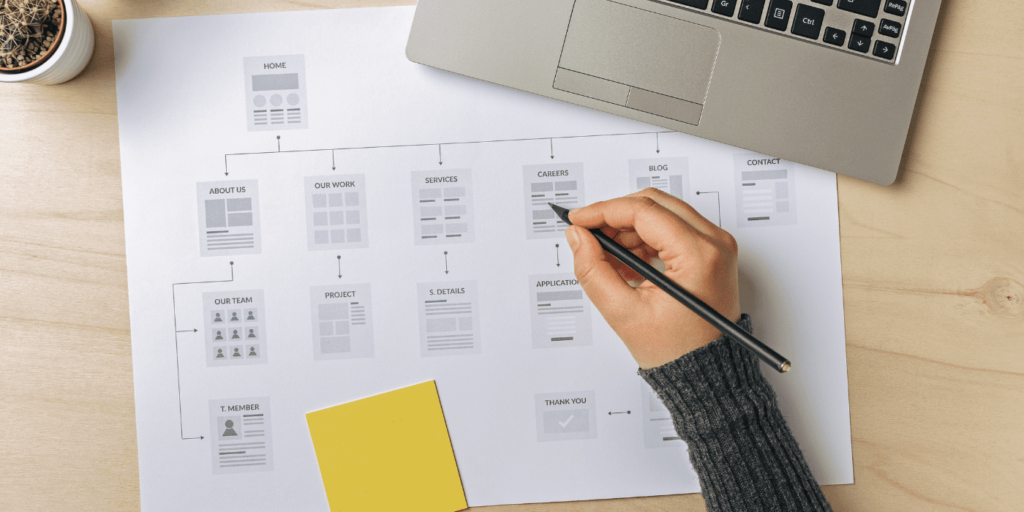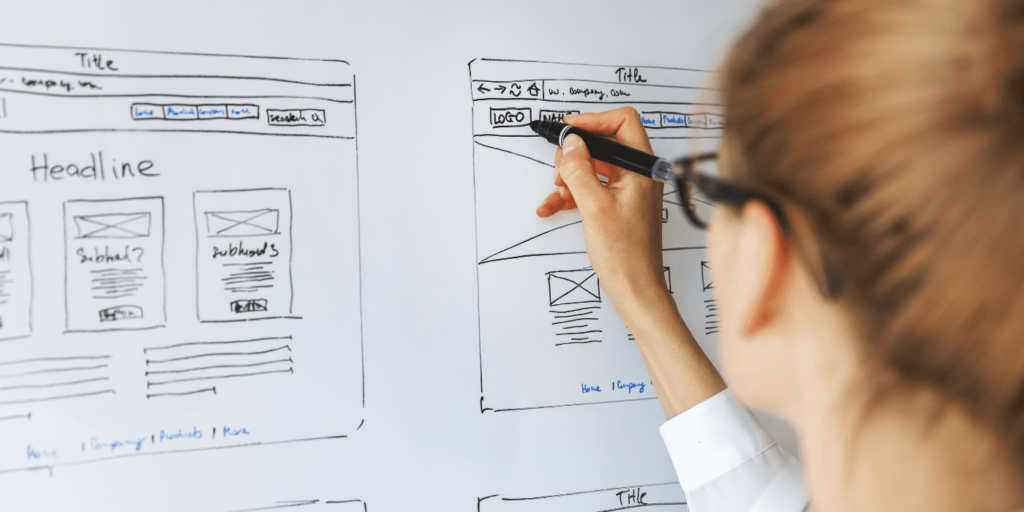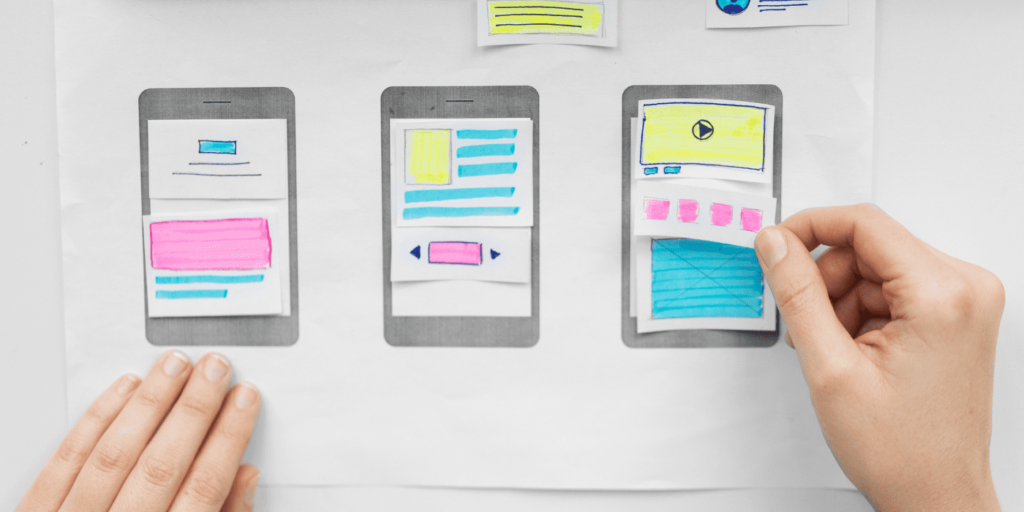Before creating a professional website, we invest time in the so-called preliminary stages. The website is the home of Brands, the virtual place capable of attracting and especially retaining audiences.
Nothing can be left to chance, from the organization of the sitemap, to the content, which, however, is not the subject of this article.
Create a professional website in 4 steps
When we start to create a business website, there are 4 basic steps that we follow:
- Definition & Planning
- Building Information Architecture
- Wireframing
- UI Designing.
1. Creating a professional website from Definition & Planning
At this stage we ask a series of questions, prerequisites for creating an effective User Experience on the website of the brand that entrusts us with the design of the corporate website. There are 8 questions we need to answer:
- Who will be the users of the brand site?
- Why should they visit and navigate it?
- What goals should the site accomplish?
- How do we measure these goals?
- How will the site be positioned in relation to the overall Brand strategy?
- What is the technology already in place? For example, is there an old version of the site already online?
- What are the Brand’s main competitors? How do they position themselves online?
- How will we position ourselves online and differentiate ourselves from competitors?
The answers to these questions are the vademecum of the website creation project and are the guide not only to making a professional website, but also to establishing theInformation Architecture of the website.
2. Creating a professional website: Building Information Architecture
Information Architecture (IA) is the skeleton of a website. We achieve it by best organizing the content and the flow of users navigating within this content. If the user finds what they are looking for very easily, it means that the Information Architecture of the site is well organized and works.
When the client asks us how to create a business website that works, we answer that first of all the content must be strategic and, more in detail:
- Relevant, served in the right place at the right time;
- appropriate, that is, understandable as well as being exactly what the user is looking for;
- useful, it must serve to make the user make a decision (make him take an action).
In essence, we set up the Information Architecture on the characteristics of the brand’s potential users before creating the User Interface of the website.

From the study of AI, comesNavigation Design:
- In the main menu(Primary Navigation) we include site content that might be of interest to most visitors. In other words, we are talking about the content for which users will decide to click on the brand link and land on your site.
- In the secondary menu(Secondary Navigation) we include content that does not serve the main purpose of the site but still may be relevant to some users. For example: the Blog page, the Contact page etc.
From the choices made at this stage comes the sitemap: the visual representation of AI. The sitemap communicates with search engines and explains to them how the pages of the site are organized and hierarchized.
3. Creating a professional website: Wireframing
The Wireframe is a draft of the page structure of a Web site. It is the skeleton of each section, around which we create the final design of the pages.
We need this draft to connect the Information Architecture we designed for the brand website to what will be its visual design. In other words, the Wireframe puts into practice the choices made in organizing the User Experience.
Please note: Before we get to this step, we must have created and structured all of the site content, i.e., text and buttons (technically called Call To Action).

At the wireframing stage it is important:
- Sketching. We do not think about the graphical appearance and details of the UI, we just need to place the content in the different sections, keeping the structure of information as the only focus.
- Keep the UI generic. No images (only boxes with Xs as large as the space the image will cover), no custom fonts, and no colors. Text and CTA only: font size and bold thickness will determine the importance of text sections and buttons.
- Use grids to check whether section layouts are adaptable to the size of various devices (desktop to mobile).
- Also consider the structure of pages and error messages (what happens if a user makes a mistake in filling out a form? What message appears on his or her screen?).
4. Creating a professional website: UI Designing
TheUser Interface (UI ) encourages the visitor to discover what is beyond the first screen he or she views. Once we get the user to that point, we must not risk confusing him or her.
The basic principles for structuring the User Interface.
1) Brand Matters
We build a consistent and unique brand identity.
Brand is the main means by which small companies become big, and it is also the reason why the biggest ones stay on top.
Your website must communicate brand identity and answer this question, “What does this person, service or product do to be unique and different from businesses in the same industry?”
2) Audience First
When designing your website we always keep your brand’s audience in mind. It is the audience, with its tastes and needs, that influences user interface design. Personal opinion or the tastes of the web designer, alas, have no relevance.

3) Design for a purpose
A generic User Interface is easy to implement, but it is equally easy to forget.
Answer this question: how many sites are similar to each other?
This happens because in web design we often follow stylistic trends that are defined as universally valid.
But a widespread UI Design trend is no guarantee of success.
4) Information Priority
Every decision we make about the UI will provide evidence of the added value your site can provide to the visitor.
In the first 3-5 seconds that the user spends on the site, they will clearly perceive the message your brand wants to convey. Then, from the very first action it takes (click, scroll down, etc.), it must have confirmation of the value communicated by the first screen.
If users feel this value added to the first action, they will also perform the second, third and so on, having the confidence that they are on the right direction to navigate to their goal (the one they landed on your brand’s site for).
And that is nothing but the main goal: to lead the user to take an action!
Conclusion
Now, however, comes the fun part: you have to create your brand website! We have explained how we do it and what some of our strategies are.
What can you do? Ask Larry for support!
At Larry Agency we do web design.
Take a tour of our Portfolio and write to us if you need a Branding agency to take care of your website.
The next Larry Agency signature success case could be yours!







